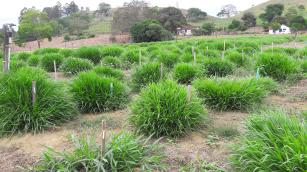Forage potential of improved genotype of Brachiaria ruziziensis: management strategies and milk production under rotational grazing
Forage potential of improved genotype of Brachiaria ruziziensis: management strategies and milk production under rotational grazing

Photo: Sobrinho, Fausto
Forage crops of the genus Brachiaria are the most important for feeding the herd in dairy farming systems in the tropics. B. ruziziensis is recognized as having the best nutritional value but is less productive than other Brachiaria species besides being susceptible to feeding damage caused by spittlebug, thus limiting its use by dairy farmers. The breeding program of B. ruziziensis, carried out by Embrapa in partnership with other institutions, has selected an improved genotype of high productivity, good nutritional value and greater resistance to the spittlebugs, when compared to commercial cultivar of B. ruziziensis. The expression of the forage potential of the improved genotype depends on appropriate management recommendations. This project aims to evaluate strategies of nitrogen fertilization, planting densities, defoliation intensities and the potential for milk production in pastures established with an improved genotype of B. ruziziensis. The N response curve is being evaluated by applying five doses of N (0, 80, 160, 320 and 640 kg / ha of N). The dose identified as the most adequate will be evaluated in split application strategies, in order to determine the most efficient one. The interaction between planting densities and defoliation intensities will be evaluated in a factorial experiment with two planting densities (15 and 30 plants per m2) and three defoliation intensities (30, 50 and 70% height reduction). The potential for milk production of Holstein x Zebu cows under grazing regime will be evaluated, using the management strategies defined in the experiments described above. The following characteristics will be evaluated: plant height, tiller density, morphological composition, forage accumulation and mass, nutritive value of pasture, carrying capacity and milk production per animal and per hectare. The following results are expected: i) dosing and splitting of N to B. ruziziensis; ii) Definition of planting density and protocol for the grazing management of B. ruziziensis, and iii) determination of the potential for milk production in pastures of an improved genotype of B. ruziziensis. The knowledge generated may contribute to the release of a new forage cultivar, which may represent an innovation for intensification of pasture-based milk production systems. Dairy farmers will be able to adopt the new cultivar and apply the management recommendations generated in this project, which may increase the productive and economic efficiency of milk production systems.
Status: Completed Start date: Sun Oct 01 00:00:00 GMT-03:00 2017 Conclusion date: Wed Sep 30 00:00:00 GMT-03:00 2020
Head Unit: Embrapa Dairy Cattle
Project leader: Domingos Savio Campos Paciullo
Contact: domingos.paciullo@embrapa.br
